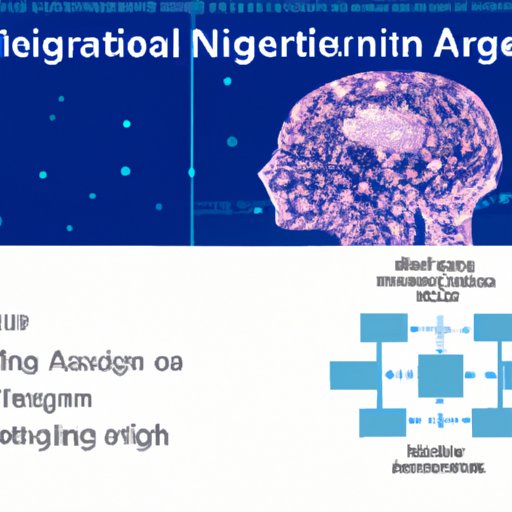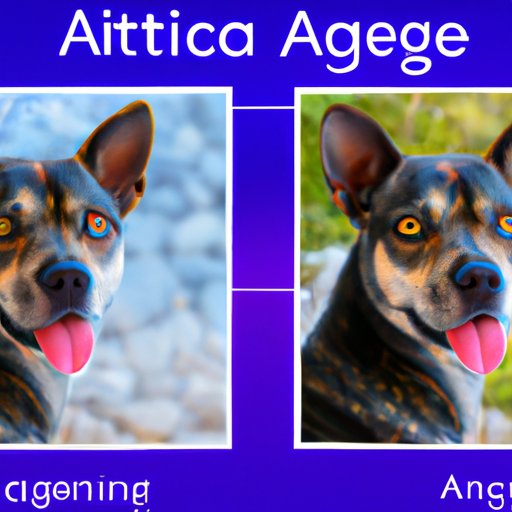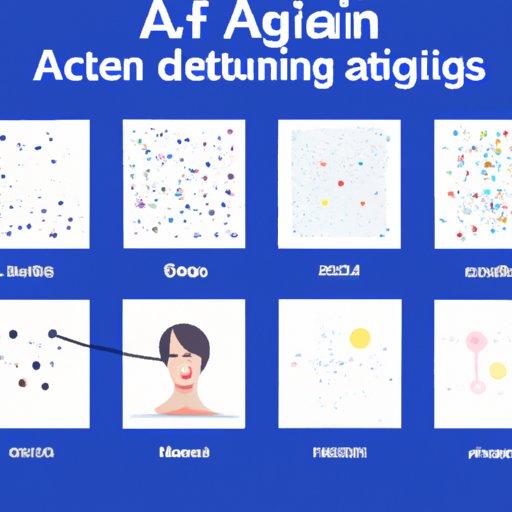Introduction
Artificial intelligence (AI) is a rapidly advancing field with far-reaching implications. One of the most exciting applications of AI is in the area of image generation, which involves using algorithms to generate realistic images from scratch. This technology has the potential to revolutionize creative industries, from design and photography to videography and beyond. In this article, we’ll explore how AI image generation works and examine the potential applications, algorithms, and benefits of this technology.
Exploring the Basics of AI Image Generation
Before diving into the specifics of AI image generation, let’s take a look at what it is and how it works. AI image generation is a process that uses algorithms to generate images from scratch. By leveraging the power of machine learning and deep learning techniques, AI image generation algorithms can create highly realistic images without any human input.
A Step-by-Step Guide to AI Image Generation
AI image generation requires data as input, typically in the form of photographs or existing artwork. This data is then fed into an AI image generation algorithm, which generates new images based on the input data. The process can be broken down into three main steps: understanding data requirements, implementing AI image generation algorithms, and generating outputs.
Understanding Data Requirements
The first step in AI image generation is understanding the data requirements. This includes gathering the necessary data and preprocessing it if necessary. Depending on the type of algorithm used, different types of data may be needed, such as photographs, illustrations, or artwork. It’s important to ensure that the data is of high quality, as this will affect the quality of the output images.
Implementing AI Image Generation Algorithms
Once the data is collected and preprocessed, the next step is to implement an AI image generation algorithm. There are several types of algorithms available, each with its own strengths and weaknesses. Some of the most popular algorithms include generative adversarial networks (GANs), variational autoencoders (VAEs), and convolutional neural networks (CNNs). It’s important to choose the right algorithm for the task at hand, as this will determine the quality of the output images.
Generating Outputs
Once the algorithm is chosen and implemented, the AI image generation system can begin generating output images. This process typically takes some time, as the algorithm must learn the patterns in the data and generate new images accordingly. Once the process is complete, the output images can be inspected and refined if necessary.
How AI Image Generation is Changing Creative Industries
AI image generation is having a profound impact on creative industries. From designers and artists to photographers and videographers, AI image generation is transforming the way these professionals work. Let’s take a closer look at how AI image generation is changing the creative landscape.
Impact on Designers and Artists
Designers and artists are some of the biggest beneficiaries of AI image generation technology. AI image generation algorithms can be used to generate unique designs and artwork, allowing designers and artists to create stunning visuals with minimal effort. According to a study by Adobe, “AI-generated art is increasingly seen as a viable alternative to traditional methods, providing a cost-effective way to produce creative content quickly and efficiently.”
Impact on Photography and Videography
Photographers and videographers are also taking advantage of AI image generation technology. AI image generation algorithms can be used to generate realistic images and videos from existing footage, allowing professionals to create more compelling visuals with less effort. AI image generation algorithms can also be used to enhance existing images and videos by adding details, color corrections, and other effects.
Potential Applications
The potential applications of AI image generation are virtually limitless. AI image generation algorithms can be used to generate realistic product images, abstract art, medical images, and much more. AI image generation can also be used to create virtual environments and objects, making it an invaluable tool for video game developers and filmmakers.

Examining AI Image Generation Algorithms and Best Practices
When it comes to AI image generation, selecting the right algorithm and implementing it correctly is essential for achieving the best results. Let’s take a look at some of the most popular algorithms and best practices for implementation.
Types of Algorithms
As mentioned earlier, there are several types of algorithms available for AI image generation. GANs, VAEs, and CNNs are the most commonly used algorithms, but there are many others as well. Each algorithm has its own advantages and disadvantages, so it’s important to choose the right one for the task at hand.
Advantages and Disadvantages
Each algorithm has its own set of advantages and disadvantages. GANs are capable of generating highly realistic images, but they can be difficult to train and require large amounts of data. VAEs are easier to train and require less data, but their output images may not be as realistic. CNNs offer a balance between realism and training complexity, but they tend to be computationally expensive.
Implementation Strategies
When implementing an AI image generation algorithm, it’s important to consider best practices and optimization strategies. For example, data augmentation can be used to improve the accuracy and realism of the generated images. Additionally, hyperparameter tuning can help optimize the algorithm’s performance. Finally, it’s important to monitor the algorithm’s performance over time to ensure that it continues to generate high-quality images.

The Role of Deep Learning in AI Image Generation
Deep learning is a powerful tool for AI image generation. Deep learning techniques allow AI image generation algorithms to generate highly realistic images by leveraging the power of artificial neural networks. Let’s take a look at some of the key benefits of using deep learning for AI image generation.
Exploring Deep Learning Techniques
Deep learning techniques involve training artificial neural networks on large datasets. These networks are then used to generate images from scratch or modify existing images. Deep learning techniques have been used for a variety of tasks, from facial recognition to object detection.
Benefits of Using Deep Learning
Using deep learning for AI image generation offers several benefits. Deep learning algorithms are capable of generating highly realistic images, and they can be trained on large datasets. Additionally, they are scalable and can be adapted to different tasks. Finally, deep learning algorithms can be optimized and tuned to achieve the best results.
Challenges of Using Deep Learning
While deep learning can provide significant benefits for AI image generation, it also presents some challenges. Deep learning algorithms require large amounts of data and can be computationally expensive. Additionally, they can be difficult to train and prone to overfitting. It’s important to consider these challenges when implementing a deep learning algorithm for AI image generation.

Taking a Look at the Benefits of AI Image Generation
AI image generation has the potential to revolutionize creative industries. It can save time and money while improving the quality of output images. Let’s take a look at some of the key benefits of AI image generation.
Cost Savings
One of the biggest benefits of AI image generation is cost savings. By leveraging the power of AI, businesses can reduce the costs associated with creating images and videos. This can free up resources for other projects and help businesses stay competitive.
Improved Quality
AI image generation algorithms can generate high-quality images and videos with minimal effort. This allows businesses to create stunning visuals with minimal cost and effort. Additionally, AI image generation algorithms can be used to enhance existing images and videos, resulting in even higher quality output.
Increased Efficiency
AI image generation algorithms can significantly increase efficiency. By automating the image generation process, businesses can reduce the time and effort required to create images and videos. This can result in faster turnaround times and improved customer satisfaction.
Conclusion
AI image generation is a powerful technology with far-reaching implications. By leveraging the power of algorithms and deep learning techniques, AI image generation can generate highly realistic images from scratch. It can also be used to enhance existing images and videos, resulting in stunning visuals with minimal effort. AI image generation can save time and money while improving the quality of output images, making it an invaluable tool for creative professionals.
Summary
In summary, AI image generation is a powerful technology that can revolutionize creative industries. It involves using algorithms to generate images from scratch, resulting in highly realistic images with minimal effort. AI image generation algorithms can be used to generate unique designs, enhance existing images and videos, and much more. Additionally, AI image generation can reduce costs, improve quality, and increase efficiency.
Final Thoughts
AI image generation is a rapidly evolving field with far-reaching implications. As the technology continues to advance, the potential applications of AI image generation will only continue to grow. Businesses should take advantage of this technology to stay competitive and create stunning visuals with minimal effort.
(Note: Is this article not meeting your expectations? Do you have knowledge or insights to share? Unlock new opportunities and expand your reach by joining our authors team. Click Registration to join us and share your expertise with our readers.)
